Family : Bovidae

Text © DrSc Giuliano Russini – Biologist Zoologist

English translation by Mario Beltramini
Bos primigenius Urus
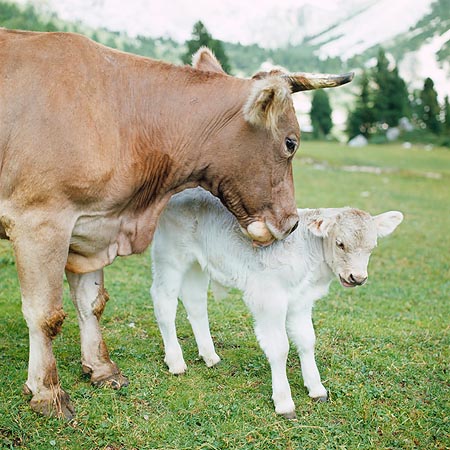
Cow with just born calf © Giuseppe Mazza
The scientific name Bos primigenius , family Bovids (Bovidae), is now not considered valid by the ICZN (the society in charge of classifying the animal species, at international level), which classifies the Urus as Bos taurus, Linnaeus, 1758, the same species as the tamed bovines. In any case, on 2003, the International Commission for Zoological Nomenclature has decided to confirm the Bos primigenius for the Urus.
Taxonomists who study the tamed bovines a subspecies of the wild Urus tend to utilize Bos primigenius taurus , whilst Bos taurus remains available for the tamed bovines when considered as a separate species.
The Urus is a species of big bovine, extinct from 1627 (where there are historical documents relating about its last traces), with presence in Europe, period during which the distribution area of this animal, since the XIII century A.D., owing to intensive hunting due to its flesh, skin and horns, it had limited to the Polish, Lithuanian, Moldavian meadows and pasturages up to the former Prussia and Transylvania. But, originally, it was present also in Asia, Middle East, North Africa (Egypt, Tunisia, Morocco, Algeria).
Once, there were three subspecies of Urus: the Bos primigenius namadicus (Falconer, 1859), living in India, the Bos primigenius mauretanicus (Thomas, 1881), of North Africa and, of course, the Bos primigenius primigenius (Bojanus, 1827), of Europe and Middle East. Only the European subspecies has survived until more recent times. The word Urus comes from the Latin, but it reached Latin from the Germanic language. In Italian, it is declined as Uro (singular) and Uri (plural). The same Germanic word, Aurochs is a combination of the root Urus with Ochs(e), ” ox “. Even if the syllable aur-/ur- has been often considered as close to the Germanic ” ur “, which means ” originary / proto “, it should be coming from another root, referring to the water. In English, the words Aurochs, Urus and Wisent are all utilized as synonyms.
In any case, this utilization is wrong, seen that the extinct Urus/Aurochs is a species completely separated from the still existing Wisent, European bison (Bison bonasus). The Uri are represented in many European paleolithic cave paintings, like those found at Lascaux and at Livernon in France. Supernatural qualities were attributed to their vital strength and they have found also old paintings representing them.
The Uri, which were rather aggressive for a ruminant and has a definitely conspicuous structure, survived during the Iron Age in Anatolia and in the Near East where were worshipped as a sacred animal, the Lunar Taurus, associated to the Mother Goddess and, later, to Mitra, a religious cult in vogue in the Mediterranean basin since the Paleochristian era and that later on contended, also at the time of the old Roman Empire, the primacy of cult to the Christian religion for a while before becoming in its turn a Coptic cult and not recognized.
The taming of the Urus began in southern Caucasus and in Upper Mesopotamia starting from the IV century AD, whilst the genetic appearances suggest that the Uri were tamed independently in North Africa and in India. The nature of this animal was aggressive, morphologically it had big dimensions, the height at the withers reached the 175 cm, against the 150 cm of the present bovines (Bos taurus). The urus had also some appearances which are rarely found in the modern bovines, such as the lyre-shaped horns bent forwards, a pale stripe along the backbone and a sexual dimorphism in the colours of the mantle. The males were black with a paler grey or brownish stripe along the backbone, whilst the females and the calves were reddish (these colours are still now found in some domestic bovines, like the bovines of the race Jersey).
We have now to talk about an experiment which was done during the twenties and the thirties by two Biologist Zoologist brothers, the Dr. Heinz Heck (director during 25 years of the Zoological Garden Tierpark Hellabrunn of Munich, Bavaria, Germany), and his brother, Lutz Heck, director for twenty years of the Zoological Garden of Berlin, Germany.
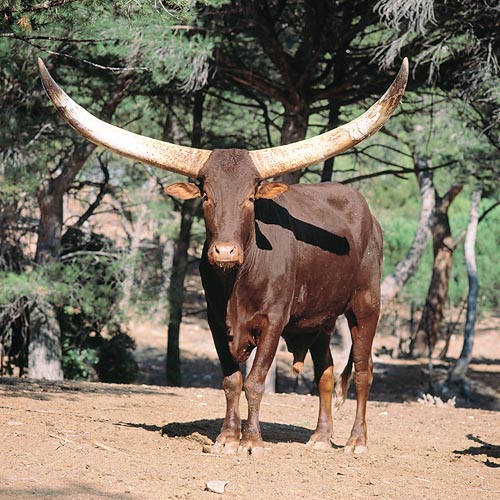
The Maasais breed Ankole-Watusi for work, milk and periodical blood takings © Mazza
These two Biologists wanted to try to bring back to life (each one independently from the other), two extinct species of animals, H. Heck the Urus (Bos taurus primigenius), and L. Heck the Tarpan (Equus ferus ferus), an Euro-Asian wild equid, the last specimen of which died in captivity in the Zoological Garden of Kiev, Ukraine, in 1918-1919.
These projects were born in the mind of above scientists, while reading some articles and writings of the Polish Zoologist Jarocki, 1853, after whom it was possible to have back in life, extinct species subspecies or animal and vegetal races, utilizing the technique of the breeding-back (where, re-crossing living animal and vegetal species, which express phenotypes recalling to the life each one or a part of the characters which were comprehensively present in the species, subspecies or ancestral race, exploiting the pool of genera which are inherited from generation to generation, between which are the ancestral ones no more expressed, it was possible to go back to the ancestral species), which is based on breeding or selective cultivation of animals or plants for causing the emersion, exploiting quantitative morphological characters, the original, primitive phenotypes, acting in such a way that the become dominant in their expression over the others, to finally obtain, in the following generations, offspring which result pure lines for the original characters.
Technique which is not to be mistaken with the ‘back-crossing” one, normally utilized also nowadays in zootechnics and in horticulture, for the production of hybrids which have a genetic patrimony close to one of the two parents. The difference stands in the fact that that start from a genetic-phenotypic hybrid which is then re-crossed with one of the two parents, or with an organism, which has a genotype and phenotype close to that of a parent, very often it’s matter in the case of animals, of specimens escaped from taming and which have reintroduced themselves in nature, spontaneously (feral animals).
The technique of the breeding-back has been later on utilized also for getting back to life other species in other projects, such as the Utonagan (breed of Dog) crossed with the breed Northern Inuit, in the attempt to get offspring with character of Wolf (Canis lupus) without couplings with them, from which they obtained the Tamaskan which really recalls the characteristics of the present Canis lupus.
Another instance is the one represented by an experiment of Japanese Biologists in the fifties, when they tried to recall in life the Japanese Wolf (Canis lupus hattai and Canis lupus hodophilax , species extinguished in 1899 and in 1901), crossing a present species of Asiatic Wolf (Canis lupus pallipes) with a race of Japanese Dog, the Shikoku, experiment which brought to life a new animal which only in part was recalling the characteristics of the extinct Japanese Wolf. It has not been classified.
About the Urus, H. Heck during his time as director of Munich Zoological Garden, did work on some heads of the Scottish race of the Highlands, on some Alpine and Frisian varieties and on specimens of Corsican race. Each one had some morphological characteristic of the ancestral Urus, colour and morphology of the mantle, sizes of the horns, etc. Time passing, his labours were rewarded, as matter of fact, two calves came to life, a male and a female, with characteristics similar to the animals present on the cave paintings of Lascaux, France. The were coupled and their young did reproduce “at the pure state” and by 1951 Heinz Heck had some forty Uri. Nowadays this rebuilt species lives mostly in the Dutch pasturages and meadows which have the most of the population.
Many Biologists Zoologist, between whom Professor Z. Pucek, Biologist of the Natural Reserve of Bialoweza, Poland, one of the greatest experts in the world about the Biology of the conservation of the European Bison (Bison bonasus) deems the rebuilt Urus, or H. Heck’s, one of the greatest frauds in the field of the applied Zoology, because, after him, and many other authors, it is impossible to bring again to life an extinct species with such procedure. Perhaps, only the technique of somatic reproductive cloning might be in condition to do so.
Bos taurus primigenius
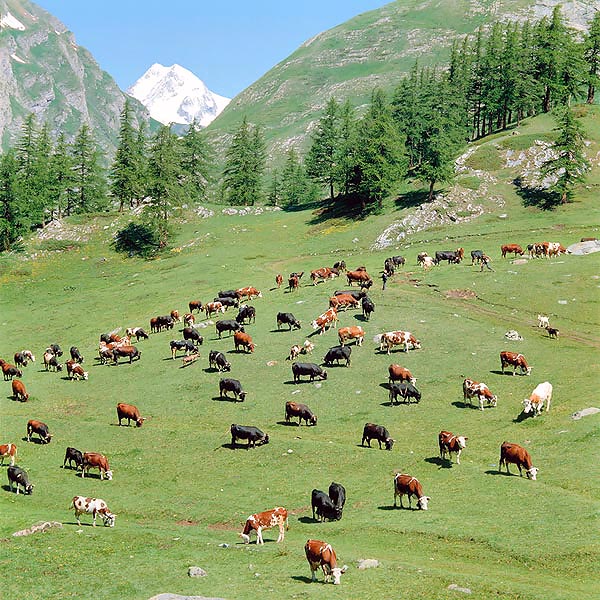
Mountain meadow with Ayrshire, Friesian and Valdostan Bos taurus © Giuseppe Mazza
Zoogeography
It was endemic to the Polish and Bielorusian plains. On the contrary, nowadays, the rebuilt species is mostly found, excepting some zoological gardens, in the Dutch pasturages.
Habitat-Ecology
Meadows, mountain Pasturages
Nutrition
Herbivore, Ruminant, several species of lawn herbs.
Morpho-physiology
Same physiological characteristics as the others bovines for the various apparatus and organs.
The dimensions of present Urus are greater than those of a normal cow (Bos taurus). For instance, the height at the withers reaches 1,6 m for the Urus of Heck against the 1,4 m for a normal cow.
The sexual dimorphism (that is, the marked difference of some somatic characters between males and females) is missing, because the mantle does not have so clearly different colours between the two sexes. The ancestral Aurochs had these differences, like a much more conspicuous mass. Some Zoologists believe that it might reach the 1500 kg of weight, roughly half than the Black Rhinoceros (Diceros bicornis) against the 1300 of the present stud bulls, which are the biggest ones. The horns of the present Urus are much longer than those of a Stud bull, an intermediate length between these ones and those of the African bovine Ankole-Watusi.
Ethology-Reproductive Biology
The Reproductive Biology and the Ethology do not have substantial differences with the other bovines, the female is subject to the first forms of rut between the 7 and the 14 months (sexual maturity). The deliveries are always single, rarely twin, never multiple. The uterus is, alike the other ruminants, bicornuate biconcamerate. The placentation is of Syndesmochorial or Cotyledonary type. That is, the one where the Trophoblast (group of embryonic in close contact with the uterine wall, from where form the embryonic and extra-embryonic cells) gets in touch only with the Connective tissue. In this type of placenta, the Chorionic Villi are dotted and are named Cotyledons.
Bos taurus
It is the common breeding Bovine (of which do exist also some wild specimens, of wild seeds). Like for other Artiodactyla or for species belonging to the Order of the Perissodactyls, there has been a strong genotypic-phenotypic politypification (both natural, and artificial, that is, induced by the man through the taming and the domestic selection) in many subspecies or races.
It would seem ascertained, by means of paleontological and genetic studies, the phylogenetic derivation of this animal species, therefore of all the races which characterize it, from a common ancestor, the Bos taurus primigenius , commonly called Uro in Italian or Aurochs, derivation from the Germanic language, which extinguished in 1627.
The Italian name “Mucca”= cow, would seem to have an etymology of doubtful or at least ambiguous derivation, after some it is coming from the Latin verbs “mulgere”, in Italian “mungere” = to milk, or “mugire”, in Italian “muggire” = to moo. Other authors believe that such word comes from the XVI century AD as an Italianization of the German word Mucke (midge) with which the Lansquenets, during their attempts to invade Italy, called the Italian cows, as they considered them smaller compared to theirs.
The female of such bovines is commonly called “Vacca”, or “Mucca”, even if in Zootechny this second name results improper.
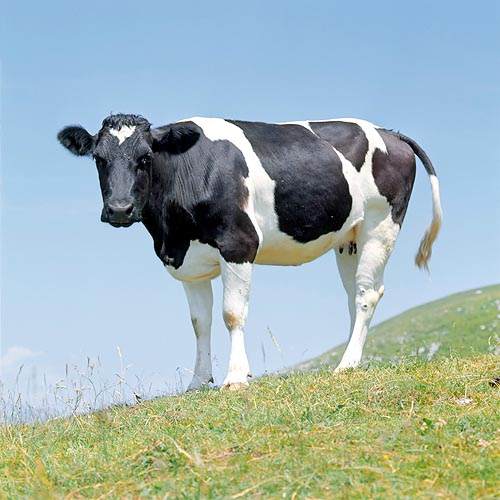
Dutch Friesian Bos taurus © Giuseppe Mazza
The males which, upon their fourth year of age (adult Bovine) are not subject to castration, are called Bulls, and they are utilized for fecundating the females for reproductive purposes, or their semen is utilized in the Zootechny field for fecundating the greatest possible quantity of females from one male only (stallion), increasing the prolificness for economical reasons, through techniques of Artificial or Instrumental Insemination (AI).
The adult male, castrated after the 4 years of age is called in Italian “Bue”, or “Bove” = ox, if the castration is effected between the first and fourth year, the animal is called “Manzo” = steer, if, on the contrary, the same happens before completing the first year of age, it will be called “Vitello” = calf.
From the above, we understand that the breeders and the Zootechnicians will apply such procedure depending on the type and quality of meat they wish to obtain.
The adult bovine female, aged more than 3 years, or being beyond the sixth month of pregnancy, is called “Vacca” = cow; when, on the contrary, it is 1 to 3 years old, or not beyond the sixth month of pregnancy is called “Manza” =
she-calf, if less than 1 year old, “Vitella” = heifer.
Finally, the cow not more than 3 years old is called “Giovenca” = young cow, utilized as brooder for the reproduction with the reproducing Bulls (stallions), or via artificial insemination.
This is a list done for clarifying how in the Zootechnical-Veterinary fields are defined the different stages of development and growth of these animals the utilization-breeding of which is merely for economical purposes. The taming of the Bovines has very old origin (from the Neolithic) and keeps up with the birth of agriculture and from the passage of human beings, from a style of nomadic life to one of type sedentary-permanent, till now they represent an essential source of proteins and animal fats through the production of meat and milk.
The Zootechny, through techniques of crossing and selection and of genetics of the quantitative characters guarantees their improvement and, during the last 50 years with the techniques of the Biology applied to the artificial insemination (AI), has produced and is always producing races which are more specific for economical purposes.
We have to recall that beyond the essential produces of which we have been talking of, also the dejections (dung or sewage) of the Bovines are utilized, and from them they can obtain many macro and micro-elements for the cultivation of agricultural lands, above all the nitrogen, chemical element essential for the growth of the plants.
As usual, there is the reverse of the medal, as such animals should be, after recent studies, one of the several causes of impoverishment of the water resources, as one milking cow can drink even 200 litres of water by day (a Bovine, between 60-90 litres, the same a Horse), with all the consequences if we multiply these values for all the heads of this cattle bred in the world.
Furthermore, their breeding is accused to be a possible cause, together with many of other origin, of the greenhouse effect, as the digestive bio-chemistry of the Bovines (and of the Ruminants as a rule) actually causes the production of methane (CH4), which is one of the gasses which more contribute to the strengthening of the greenhouse effect.
After recent studies, there should be the possibility to reduce it, modulating the bacterial charge of the digestive duct from which the produced methane component could be reduced.
As we shall see later, the classification of these animals cannot be lead to parameters which are usually utilized for those of other species, as it has several problems of somatic-phenotypic type (colour and typology of the mantle, dimension and size of the horns, etc, …) and bio-geographic as they are now present all over the world and in most of the eco-systems, or because autochthonous or because imported by the human being (for instance in Australia).
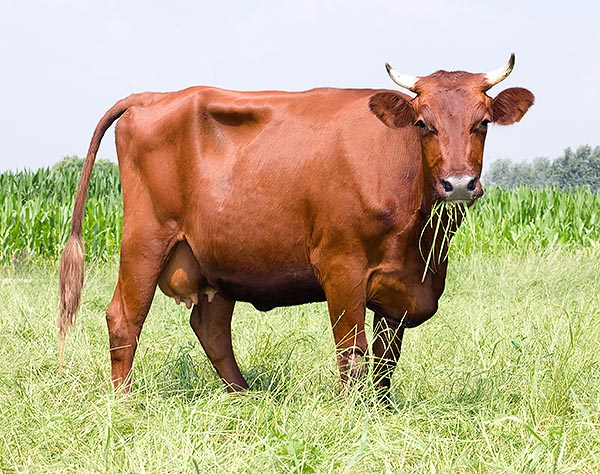
Angler cow while grazing © Giuseppe Mazza
For this purpose, the biologists have proposed a classification accepted universally based on the attitude of the animal, that is Breed for Milk, or lactiferous (utilized for the production of milk), Breed for Meat (utilized for the production of meat), Breed for Production of Skins, Breed for Burden or for Work (utilized for doing heavy agricultural works, like the ploughing of the fields and, for the transportation of weights excessive for the man), these last breeds, are actually utilized mainly in villages of the countries in expansion (Africa, South America, Asia, Indo China), as in the Western World, where the agriculture has reached extremely developed and refined levels of mechanization, they have guaranteed the exemption of such races for this purpose.
A last classification is directed to those breeds which have a double or triple attitude (that is, can be both Lactiferous and Producers of Meat, or Lactiferous, Producers of Meat and Burden animals, that is Producers of Work).
Here are some examples:
Lactiferous Breeds: Jersey, Freisian, Ayrshire, Guernsey, Brown, Alpine, Valdostana.
Meat Breeds: Shorton, Angus, Aberdeen, Hereford, Limousine, Charolais
Milk and Meat (double aptitude) Breeds: Chianina, Maremmana, Romagnola, Marchigiana, Podolica, Red Poll
Milk, Meat and Work (triple aptitude) Breeds: Reggiana, Piedmontese, Burlina, Simmenthal.
Some exotic domestic species utilized always for the production of Milk, Meat, Skins and Work, are: Bos taurus indicus (Zebu), present in Asia, Africa and South America, Bos javanicus (Benteng), present in various areas of South East Asia (Java, Bali, Borneo, Thailand, Malaysia), Bos grunniens (Yak), endemic of Tibetan Plateau. We shall describe, in a general way, the characters of the Bos taurus, as the differences in the single species are not so far marked from species to species.
Zoogeography
Cosmopolitan species, present everywhere but the Poles and some areas in Oceania; for instance, the islets off the north-eastern coast of New Zealand North Island, where their breeding, as well as that of the sheep and goats, is forbidden by the Government in order to protect the habitat of Sphenodon punctatus.
Habitat-Ecology
At semi-wild, wild are meadows and plain and mountain pasturages, in some cases also woody areas, or formed by shrubs, like for the African bovine Bos taurus indicus.
We have different conditions for the breeding and domestic species, depending if the animals are allowed to be bred in the wild, the pre-eminently habitats will be the plain and mountain (for instance Alpine) pasturages, or dryer zones if we talk about North Africa (Saharan), United States (Texas, Arizona), richer of vegetation (Sub-Saharan Africa), humid zones (Indo China).
Presently different breeding conditions are offered to such species in the zootechnical field, and they are as follows:
Wild Breeding: as above.
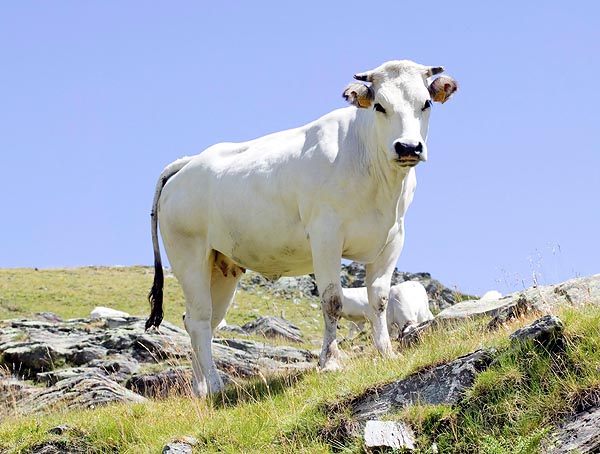
The White Modena is an excellent milk cow © Giuseppe Mazza
Semi-wild Breeding: The animals are left at the pasturage for most of the year and then closed in a stable for a certain period, where they will be nourished with specific forages for integrating their diet and compensating possible organic deficiencies.
Stable Breeding: The animal is bred with a closed system and always kept in the stable, where it comes to life and grows up getting fat, the animal will be taken out specifically for butchery. Also the Milk Cows are, in some cases, bred in this way, where automated stables for the milking guarantee the milk collection twice a day.
Free Stabling: can be applied both in closed and open stables. In the first case, the animals live in the shelters, where they nourish and drink water, but can freely move in the enclosures which communicate with the outside. In the second case, the animals live in enclosures in open air, where shelters are prepared, where they nourish, drink and take cover from the excessive heat and from the rain.
Morpho physiology
They are cavicorn (that is, having hollow horns) animals, horns which are not caduceus, not falling like those of the Cervidae (Deer and Elks). Contrary to Cervidae, there is no sexual dimorphism (that is the presence of one character only in one of the two sexes, almost always in favour of the male), concerning the horns, as both sexes have them, even if they are more marked in the male. The horns are hollow keratinous tissues (from which cavicorn), filled by the extension of the frontal bone, are curved either backwards, or sideward or prolonged forward, but never ramified or caduceus.
The length can be of 20-30 cm, like in the breed Freisian to the breeds like the English Longhorn which have horns of exceptional dimensions, long even 1 metre; the section of the horns can be circular or triangular. They have a massive structure, these breeds usually weigh 650-700 kg for the Cows, 1200-1300 kg for the Bulls. At the withers, the females (Cows) can reach 150 cm, the Bulls, 160-170 cm. The biggest breeds are the Italian Chianina and the French Blonde d’Aquitaine, which can reach, at the withers, the 185 cm of height, the Bulls of these breeds can weigh even 1700 kg.
The Bovines hold 32 teeth totally, the upper incisors and the canines are missing. They have a mantle with short hair and a thin tail, ending in a tuft. Some have a great mass of flabby skin from the chest to the neck, called dewlap, others have a muscular complex very evident on the back, at the level of the Withers, called Hump. The colour of the mantle is extremely variegated, depending on the breed. They have a Herbivorous (phytophagous) cud-chewing alimentation, to which corresponds a specific digestive physiology and anatomy, they are provided of 3 pre-stomachs of oesophagus origin, reticulum, rumen and omasum and a glandular stomach abomasum, each one is in charge of a specific phase of the digestive function (for details, please go to Artiodactyla). During milking, the milk goes directly from the stomach to the abomasum of the calf, not involving reticulum, rumen and omasum, which will become biologically active after the weaning.
Ethology-Reproductive Biology
The females become sexually mature when 10-12 months old, the males between 9 and 15 months. The best age for the reproduction is 15-18 months for the male, and 16-24 for the female, the pregnancy lasts for an average of 280 days.
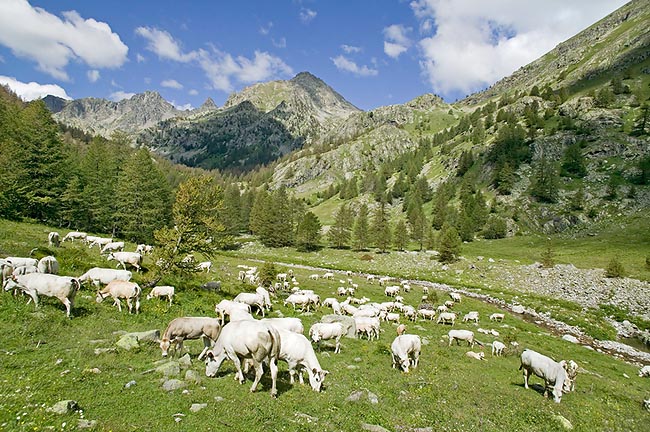
Mountain meadows with White Modena Bos taurus walking even on heaps of stones © Giuseppe Mazza
Upon birth, the calf must assume the colostrum from the mother (absolutely, some litres during the first 24/36 hours, in order to get the antibodies of which is not provided at the birth).
In fact, just after the delivery, the cow does not produce milk, but colostrum, a liquid with characteristics similar to the milk, containing high concentrations of antibodies, indispensable for protecting the young from the infections, till when it will be capable to produce them by itself. After about one week, the milk becomes suitable for human utilization (consumption and dairy). Once ended with the colostrum, the calf will be nourished with artificial milk, then, later (by the sixth month of life), it will be weaned.
Deliveries are always single, rarely twins, never multiple. The Uterus is, like the other ruminants, bicournate biconcamerate. The placentation is of Syndesmochorial or Cotyledonary type (that is, the one where the Trophoblast-group of embryonic cells in close contact with the uterine wall, and extra-embryonic), gets in touch only with the Connective tissue. In this type of placenta, the Chorionic Villi are dotted and are named Cotyledons.
Among the various pathologies affecting the Bovines, one which is cause of enormous economical damages for the Zootechny, is the Brucellosis abortus, zoonosis caused by bacteria belonging to the genus Brucellosis (the name Brucella comes from the Micro biologist Sir David Bruce, who isolated this pathogen in 1886, from the spleen of a soldier). This agent does not infect Bovines and Cows only, but also dogs, rodents, Buffalos, Camels.
In the case of the Milking cows, the etiological sub-type is the Brucellosis melitensis.
The natural host of Brucellosis melitensis is the goat, whilst the guest where the same is more diffused is the sheep.
It causes miscarriage to the goat, as well as to the sheep. The miscarriage happens during the last three months of pregnancy due to the infection. As the placenta and the aborted foetus are heavily contaminated by the Brucella, they provoke the spreading of the micro-organism in the environment and the exposure to the sickness for other still not infected animals.
Therefore, the migrating flocks present the major risk for the breeding of milking cows, as they are nourished with forages coming from areas where the flocks have been grazing.
Another possible way of transmission of the sickness can be by direct contact between infected animals and cows grazing in the same field. The dogs and other carnivores present a particular risk for the enclosed breeding (and for their owners), as they can dig the ground and find the remains of the placentas and of the aborted foeti and carry this infected material into the unimpaired breeding.
Brucellosis melitensis is the most virulent species of brucellas.
It is seldom cause of miscarriage in the bovines. The Brucellosis melitensis is excreted in the milk of infected cows and in such way the transmission to the calves can happen, causing their demise; furthermore, through the milk, it can reach the human being, in whom it is very virulent, with consequent fever rushes and damages to the net of the lymph nodes, kidneys, liver, bone marrow and spleen.
→ For general information about ARTIODACTYLA please click here.
